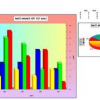Free Online Productivity Tools
i2Speak
i2Symbol
i2OCR
iTex2Img
iWeb2Print
iWeb2Shot
i2Type
iPdf2Split
iPdf2Merge
i2Bopomofo
i2Arabic
i2Style
i2Image
i2PDF
iLatex2Rtf
Sci2ools
ICIP
1999
IEEE
1999
IEEE
Simplified Segmentation for Compound Image Compression
There are three basic segmentation schemes for compound image compression: object-based, layer-based, and block-based. This work discusses the relative advantages of each scheme and architecture, and studies the use of fast classification techniques for a segmentation that can be used together with a chosen compression architecture. Particularly, we consider classification techniques working on approximate object boundaries, which reduces the localization and precision of the segmentation, but in exchange allows faster, one-pass segmentation, low memory requirements, and a segmentation map that is better matched to existing compression methods. We show numerical results obtained on a printer application environment, where rigorous standards of visual quality have to be satisfied.
Basic Segmentation Schemes | ICIP 1999 | Image Processing | One-pass Segmentation | Segmentation Map |
| Added | 25 Oct 2009 |
| Updated | 26 Oct 2009 |
| Type | Conference |
| Year | 1999 |
| Where | ICIP |
| Authors | Amir Said, Alexander Drukarev |
Comments (0)

